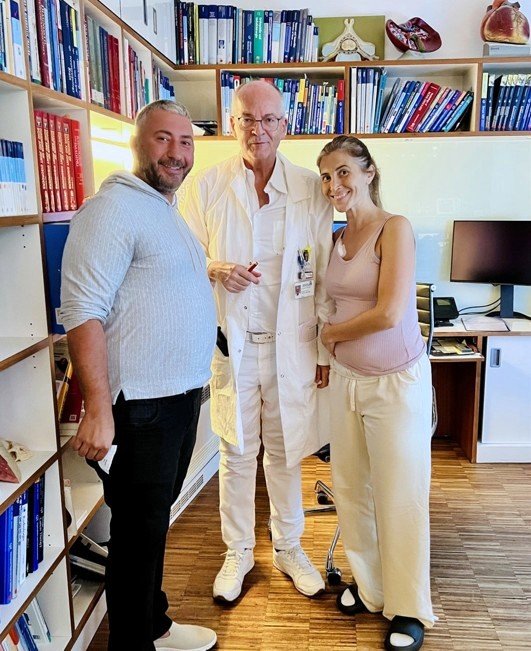
Therapeutic radionuclides Lutetium-177-PSMA, Actinium-225-PSMA, and Radium-223 have been successfully used in the treatment of advanced prostate cancer.
Metastatic prostate cancer, particularly metastatic castration-resistant prostate cancer (mCRPC), poses significant challenges due to its resistance to traditional hormonal therapies and its tendency to spread, often to bones. In Germany, cancer treatment leverages cutting-edge radioligand therapies such as Lutetium-177 (Lu-177), Actinium-225 (Ac-225), and Radium-223 (Ra-223) to target prostate cancer cells with precision, improving survival and quality of life. These innovative cancer treatments are delivered by expert doctors in Germany.
Metastatic prostate cancer occurs when cancer spreads beyond the prostate, commonly to bones, lymph nodes, or organs like the liver or lungs. In mCRPC, the cancer progresses despite androgen deprivation therapy, necessitating advanced treatments. Radioligand therapies like Lu-177, Ac-225, and Ra-223 target prostate-specific membrane antigen (PSMA) or bone metastases, delivering radiation directly to cancer cells while sparing healthy tissues.
These therapies address health factors such as obesity, diabetes, high cholesterol (hyperlipidemia), and autoimmune diseases, improving quality of life after treatment. Hospitals combine these with immunotherapy and targeted therapy for optimal outcomes.
Lutetium-177 (Lu-177) PSMA Therapy
Lu-177 PSMA therapy is a beta-emitting radioligand therapy approved by the FDA in 2022 for mCRPC with PSMA-positive tumors. It binds to PSMA receptors, overexpressed in 80-90% of prostate cancers, delivering beta radiation to destroy cancer cells. The process involves:
German oncologists report a 50% PSA decline in 49% of patients, with a median overall survival (OS) of 15.3 months per the VISION trial.
Actinium-225 (Ac-225) PSMA Therapy
Ac-225 PSMA therapy is an alpha-emitting radioligand therapy under investigation for mCRPC, particularly after Lu-177 failure. Its high linear energy transfer (LET) and short radiation range (1-2 cells) maximize tumor damage while minimizing harm to healthy tissues. The process mirrors Lu-177, with cycles tailored to disease spread. A meta-analysis showed an 81% PSA decline rate, with 60% achieving over 50% reduction. Ac-225 is noted for efficacy in disseminated metastases but is limited by supply constraints.
Radium-223 (Ra-223) Therapy
Ra-223, an alpha-emitting therapy approved for mCRPC with bone metastases, mimics calcium to target osteoblastic lesions. Administered as Xofigo (55 kBq/kg every 4 weeks, 6 cycles), it reduces bone pain and prolongs survival. The ALSYMPCA trial reported a median OS of 14.9 months. Ra-223 is less effective for soft tissue metastases, making it complementary to PSMA-based therapies.
Comparing Mechanisms and Indications
Doctors sequence these therapies based on disease characteristics, often using Ac-225 or Ra-223 after Lu-177 failure, per latest research in cancer treatment.
Efficacy and Clinical Outcomes
Lutetium-177
The VISION trial demonstrated Lu-177 PSMA-617 extended median OS to 15.3 months vs. 11.3 months with standard care, with a 30% 5-year survival rate and 2-year remission in 30-40% of patients. It significantly reduces PSA and improves radiographic progression-free survival (rPFS). Hospitals report 80% of patients experience PSA decline, with minimal toxicity.
Actinium-225
The WARMTH Act trial and meta-analyses indicate Ac-225 PSMA achieves a 60% rate of over 50% PSA decline, with improved survival in Lu-177 non-responders. Its longer half-life (10 days vs. 6.5 days for Lu-177) and stronger receptor binding enhance therapeutic duration. Early ACCEL trial results show reduced toxicity, positioning Ac-225 as a promising option.
Radium-223
The ALSYMPCA trial showed Ra-223 extends median OS to 14.9 months and reduces pain in bone metastases. It’s less effective for visceral metastases, but sequential use with Lu-177 (RALU study) shows similar OS regardless of timing, with 71-82% experiencing treatment-related adverse events (TRAEs).
Side Effects and Safety
Hospitals monitor blood counts and salivary function, ensuring quality of life after treatment in Germany.
Why These Therapies Are Effective for Metastatic Prostate Cancer
Metastatic prostate cancer requires therapies that target disseminated disease while minimizing toxicity. Doctors integrate Lu-177, Ac-225, and Ra-223 because:
Benefits of Combined or Sequential Therapies
Integrating with Other Cancer Treatments
These therapies are combined with cancer treatment options for enhanced efficacy:
Hospitals tailor these combinations based on latest research in cancer treatment.
Complementary Therapies Supporting Prostate Cancer Treatment
Complementary therapies enhance outcomes:
These are standard in hospitals, ensuring holistic cancer therapy in Germany.
Why Germany Excels in Prostate Cancer Treatment
Germany leads in cancer treatment due to:
Conclusion
Metastatic prostate cancer, utilizing Lutetium-177, Actinium-225, and Radium-223, offers targeted, effective solutions for mCRPC. Lu-177 addresses widespread disease, Ac-225 targets resistant metastases, and Ra-223 manages bone lesions, collectively improving survival and quality of life after treatment. Integrated with targeted therapy, immunotherapy, and complementary therapies, these treatments are delivered by expertGerman oncologists in leading hospitals.
🌍Why Patients Worldwide Prefer Our Medical Services in Germany – Key Benefits Explained:
FAQs
Which hospitals offer Lu-177, Ac-225, and Ra-223 therapies for prostate cancer in Germany?
Specialized hospitals and cancer clinics provide these therapies, delivered by specialists. . The choice of hospital may depend on specific treatment needs, expertise, and patient preferences
How much do these therapies cost for prostate cancer in Germany?
Cost of these therapies varies depending on the treatment plan, the hospital, and individual needs.
Can these therapies cure metastatic prostate cancer in Germany?
They extend survival and control disease, improving quality of life after, but are not curative.
What types of prostate cancer are treated with these therapies in Germany?
mCRPC with PSMA-positive tumors (Lu-177, Ac-225) or bone metastases (Ra-223), per latest research in cancer treatment.
Why do doctors choose these therapies for prostate cancer in Germany?
They’re precise, target specific cancer sites, and complement other cancer treatment options.
Are clinical trials available for these therapies in Germany?
Yes, hospitals in Germany offer trials for Ac-225 and combinations, advancing innovative cancer treatments in Germany.
How does prostate cancer treatment in Germany compare globally?
Cancer treatment in Germany is world-class, with advanced technology and expertise from German oncologists.
How effective are these therapies for prostate cancer in Germany?
They reduce PSA, extend survival (e.g., 15.3 months for Lu-177), and improve quality of life after treatment.
Are doctors in Germany experienced with these therapies for prostate cancer?
Doctors in Germany are highly skilled in radioligand therapies, ensuring expert cancer therapy in Germany.
What is the waiting time for these therapies in Germany?
Treatment starts within 1-2 weeks.
Can I get a cost estimate for these therapies before traveling?
Yes, hospitals in Germany provide estimates based on medical records, type of treatment and individual requirements
For more information or a free consultation, visit our contact us page.
Kindly complete the form below, and our dedicated team will reach out to you promptly. We look forward to connecting with you soon!
Trierer Straße, 56072 Koblenz, Germany
.webp)
.webp)
 (1).webp)
 (1).webp)


.webp)
.webp)
 (1).webp)
 (1).webp)

